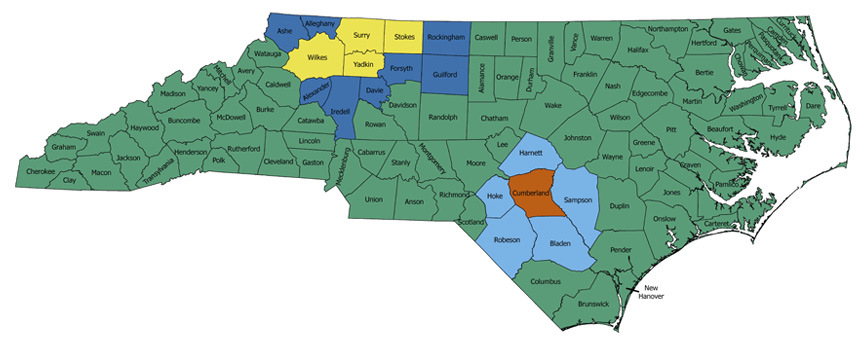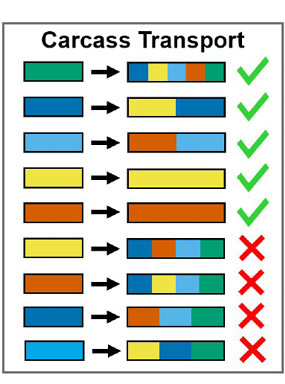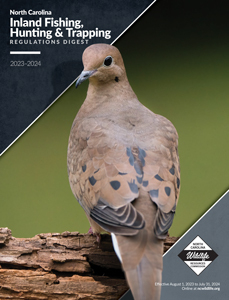CWD Surveillance Areas and Special Regulations
Two Chronic Wasting Disease (CWD) surveillance areas are defined for the 2023-2024 hunting season. Each surveillance area contains a primary surveillance area, which are counties in which CWD has been confirmed, and a secondary surveillance area, which are counties adjacent. Surveillance areas are defined in the table and map below.
Please refer to ncwildlife.org/cwd for the most current CWD testing locations, interactive maps, and regulations.

Primary Surveillance Area Counties |
Secondary Surveillance Area Counties |
|||
Surveillance Area 1 |

|
Stokes, Surry, Wilkes, Yadkin |

|
Alexander, Alleghany, Ashe, Davie, Forsyth, Guilford, Iredell, Rockingham |
Surveillance Area 2 |

|
Cumberland |

|
Bladen, Harnett, Hoke, Robeson, Sampson |
Non-surveillance Area Counties |

|
|||
Carcass Transport Restrictions
The transportation of a deer carcass or carcass parts out of a primary or secondary surveillance area is prohibited except for the following, or as otherwise permitted by the Wildlife Commission:
- Carcasses or carcass parts that originate in a secondary surveillance area may be transported into or through an adjacent primary surveillance area
- Carcasses or carcass parts that originate in non-surveillance area counties may be moved into or through a primary or secondary surveillance area
- Meat that has been boned out such that no pieces or fragments of bone remain
- Caped hides with no part of the skull or spinal column attached
- Antlers, antlers attached to cleaned skull plates, or skulls free from meat or brain tissue
- Cleaned lower jawbones with teeth or cleaned teeth
- Finished taxidermy products and tanned hides

Mandatory Sampling
Hunters that harvest a deer during the 2023-2024 season dates below must submit a sample, within two weeks of harvest, to the Wildlife Commission for CWD testing. Samples may be submitted to a Commission-staffed facility, to a Cervid Health Cooperator, or deposited in a Commission CWD Testing Drop-off Station.
- Within Surveillance Area 1, deer harvested from November 18 – December 3.
- Within Surveillance Area 2, deer harvested from November 11 – November 26
*Note: In addition to the mandatory testing dates listed above, please be aware that the NCWRC cooperates with numerous taxidermists and deer processors across North Carolina for routine surveillance for Chronic Wasting Disease. If you use these services your deer may be tested for CWD without your knowledge, but the NCWRC will inform you of the test results.
*Updated information on locations for submitting CWD samples will be available by September 1, 2023, at ncwildlife.org/cwd
Fawn Rehabilitation
Fawn rehabilitation within CWD Surveillance Areas is prohibited. Fawns may not be transported out of these Surveillance Areas and cannot be accepted by fawn rehabilitators.
Wildlife Feeding and Baiting
The placement of minerals or salt to purposely congregate wildlife is prohibited in CWD Surveillance Areas. The placement of bait, food, or food products to purposefully congregate wildlife is prohibited from January 2 – August 31 in CWD Surveillance Areas, except for:
- Bird feeders
- Hunting in urban archery seasons in participating municipalities
- Other activities specifically permitted by the Wildlife Commission
Attractants and Scents
In addition to the statewide regulations defining legal use of attractants and scents, found on General Hunting Regulations, the possession or use of products containing natural substances collected by a hunter from a legally harvested cervid in North Carolina is prohibited in CWD Surveillance Areas.

